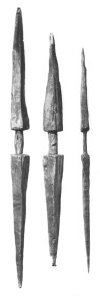The vallis
Or the pole for the palisade, has a simple double pyramid squared form with a central "handle" and it can be employed in many ways according to the camp necessities. The original and full version was written by Matthew R. Amt and is available here.
Introduction^
The palisade stake was known as vallis or sudes, not "pila muralia" or "pila castra" (term used by Caesar or Tacitus, that was probably some sort of javelin thrown by the fortifications).
Just how these stakes were employed is still debated, since they are not shown in artwork at all. They could have formed a fence on top of the rampart, or a cheveux-des-fris along the front or in the ditch.
 "caltrop" arrangement
"caltrop" arrangementThey can also be tied in threes to form large "caltrop" barriers, or lashed in pairs at intervals along a log or beam to form a movable barrier.
Quite possibly they were used in several ways on any particular fortification.
Experiments that show them to be easily pulled out if used as a fence are all done by driving them into a finished rampart, but more likely they were inserted into the rampart as it was built and the soil packed around them, so that half their length was buried. This way they would still reach up beyond the bottom edge of a defender's shield, and be much harder for an attacker to pull out.
At work!^

It is about 130-150 cm long and can be made from a 2x2, preferably oak. Some examples, like those shown below, are c. 6 cm square. The stake tapers straight to a point at both ends, and the middle is narrowed to form a "handle".
These are NOT fine woodwork! Some were better made than others, but most were very quickly made and show clear tool marks. They should not be sanded smooth, much less stained or oiled.
A legionary may have carried one or two stakes, but they were not apparently part of the regular marching load.

Sources^
- Matthew R. Amt, HANDBOOK FOR LEGIONARIES
Changelog^
- (03/09/2005) First version






